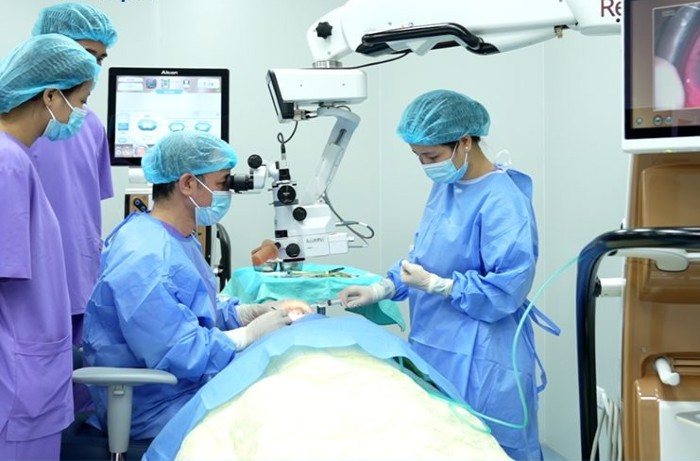A 37-year-old male patient in Hanoi , although his vision was 10/10 in both eyes, often had blurred vision when going out in strong sunlight. After going to the doctor, he was diagnosed with cataracts.
The patient works as a construction supervisor. For the past year, he often had blurred vision when working outdoors in strong sunlight. However, when he had his eyesight measured at an optical store near his home, his vision in both eyes still achieved 10/10.
 |
| Doctors in surgery perform cataract surgery on a patient. |
According to the patient, due to stress at work and not getting enough rest, his eyesight temporarily declined. He tried to rest more and use eye drops every day.
After about 3 months, Mr. Hoa's glare did not improve but even got worse, so he decided to go to Tam Anh High-Tech Eye Center for examination.
Associate Professor, Dr. Nguyen Xuan Hiep, Director of Tam Anh High-Tech Eye Center, Vice President and General Secretary of the Vietnam Ophthalmology Association, said that the results of an in-depth eye examination showed that Mr. Hoa's left eye had subcapsular cataracts and central cataracts.
The previous eye test did not detect any vision loss because the patient was in the early stages of the disease and his vision was not yet significantly affected. The patient underwent the eye test in a room with soft lighting so that the pupils were dilated, allowing the eyes to still see normally.
When exposed to strong light, the pupil contracts, limiting the amount of light reaching the retina. The patient is more sensitive to light and is easily dazzled.
Therefore, for patients coming for an eye exam, the doctor must ask very clearly about even the smallest symptoms to detect problems. In addition, in some cases, it is necessary to test vision in both bright outdoor light and in the dark to have the most accurate vision assessment.
To accurately check the condition, the doctor dilates the pupils and performs a biomicroscopic examination of the eye to determine the shape and extent of the cataract. The cataract cannot be completely cured, but the progression of the disease can be slowed down.
For early stage cataracts, to temporarily fix the problem, patients can wear dark glasses when going out in the sun, however, in the evening if eyesight is poor, they should limit jobs that require good eyesight such as driving.
In the long term, when the disease progresses to a later stage, especially for patients whose occupation requires them to work outdoors regularly, requiring good vision in all lighting conditions, surgery is the most effective and thorough treatment.
Associate Professor Hiep said that cataracts are also known as cataracts, cataracts, and dry cataracts. This disease causes the lens to become cloudy and no longer transparent, like a cloudy mirror, making it difficult for light to pass through and not converge on the retina.
In the early stages of the disease, symptoms may be unclear and difficult to recognize. When the disease is in the severe stage, it causes the patient to have impaired vision, blurred vision and risk of blindness.
The rate of age-related cataracts is most common, usually in patients over 50 years old. However, many young people also have cataracts due to causes such as eye trauma, uveitis, diabetes, congenital metabolic disorders, chronic hypocalcemia, corticosteroid abuse or taking many drugs to treat metabolic diseases such as lupus erythematosus, arthritis, gout, etc.
People who are regularly exposed to strong light sources such as car headlights shining into their eyes are also at risk of early cataracts.
Globally, cataracts are the leading cause of blindness and the second leading cause of low vision affecting all ages and ethnicities.
Of the 2.2 billion people with visual impairment worldwide , 1 billion have vision impairment that could have been prevented. Of the 1 billion people with preventable vision loss, 94 million have cataracts.
There are many types of cataracts, in locations such as the nucleus, cortex, posterior capsule or congenital cataracts... Age-related cataracts are usually nuclear cataracts.
Meanwhile, in young people, it is often opacity of the cortex and posterior capsule with symptoms such as feeling dazzled, difficulty seeing at night, halos, blurred vision, seeing objects in a brown-yellow color, double or triple vision...
In the early stages of cataracts, young people often have difficulty noticing obvious symptoms. In many cases, visual acuity in a dimly lit room is still 8/10, 9/10 or 10/10. However, when the doctor asks in depth about the signs and performs a thorough eye examination, it is possible to determine what stage the cataract has progressed to.
Associate Professor Hiep also advised patients with eye problems to go to large hospitals with reputable eye departments.
Highly specialized and experienced doctors can detect eye diseases early and accurately, thereby advising the most appropriate treatment, conservative treatment or necessary surgical intervention.
People should wear sunglasses that can protect their eyes from UV rays, have a healthy lifestyle, and eat a diet rich in food sources of lutein, zeaxanthin, omega-3 fatty acids, and vitamin C.
In addition, patients should not use drugs without a doctor's prescription because the abuse of drugs containing corticosteroids is one of the causes of cataracts, especially in young people.
According to Associate Professor Hiep, from the age of 36, you should have a regular check-up every year to measure eye pressure and screen for glaucoma risk. Over the age of 40, you should have a regular eye screening every year to screen for cataracts, glaucoma, and diabetic retinopathy.
It is known that cataract is the most common disease in the elderly, and is the leading cause of blindness worldwide. The cause of cataract can be congenital or aging - cataracts begin to appear after the age of 50.
In addition, people with diabetes, high blood pressure, people who are frequently exposed to sunlight, people who work as welders... are also causes that promote the process of cataracts earlier.
One dangerous thing is that the trend of cataracts occurring in young people is increasing, especially in those who self-medicate with drugs to treat conjunctivitis or itchy eyes containing corticosteroids, which often cause early cataracts.
In fact, ophthalmologists are concerned that many patients, especially in rural areas, do not go to the doctor because of mild itching and then arbitrarily use eye drops containing corticosteroids for a long time. This causes the patient to develop cataracts.
Symptoms of cataracts are blurred vision, double vision, and glare. The most obvious symptoms are when the patient goes out in the sun or at night when headlights shine on them, they will see a film of fog in front of their eyes. The patient always feels like there is a film of clouds in front of their eyes.
There is currently no medication to prevent cataracts, only to slow their progression. For patients who do not need a cataract replacement, there are two treatment options: observation and medication, but the most effective method is timely surgery.
Source: https://baodautu.vn/thi-luc-1010-van-bi-duc-thuy-tinh-the-d219421.html



























![[Photo] An Phu intersection project connecting Ho Chi Minh City-Long Thanh-Dau Giay expressway behind schedule](https://vstatic.vietnam.vn/vietnam/resource/IMAGE/2025/8/21/1ad80e9dd8944150bb72e6c49ecc7e08)



































![[Photo] Politburo works with the Standing Committee of Hanoi Party Committee and Ho Chi Minh City Party Committee](https://vstatic.vietnam.vn/vietnam/resource/IMAGE/2025/8/21/4f3460337a6045e7847d50d38704355d)

































Comment (0)